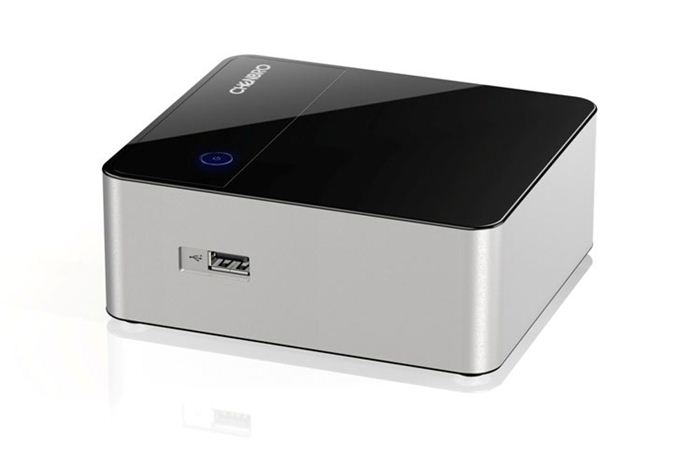Chenbro’s Cubicom 200 NUC Enclosure
by Jarred Walton on September 10, 2013 9:03 PM EST
As the demand for increased CPU performance has largely plateaued during the past five or so year, Intel has looked to expand into other markets to continue supporting the development of new technologies. Mobile has seen a large upswing in importance, and that looks set to continue, but for those that don’t need a mobile system but might like the power and small form factors associated with mobile devices, Intel created the NUC – the Next Unit of Computing. The idea is to provide all the performance of a mobile platform with the same typical feature set – USB 3.0, USB 2.0, mini-PCIe, and iGPU – without the keyboard, touchpad, display, and speakers that comprise the typical laptop. The target markets include thin clients, point of sales locations, kiosks, digital signage, surveillance, and vending machines (and anything else where you might want a tiny computer box).
Chenbro is showing off their latest NUC box at IDF 2013, the Cubicom 200. Currently supported NUC boards included the Ivy Bridge D53427RKE (Core i5-3427U) and D33217GKE (Core i3-3317U), along with a Sandy Bridge DCP847SKE (Celeron 847). All of the boards have the CPU soldered down, so that aspect is non-upgradeable, but support for two SO-DIMM slots means 16GB is possible on the DCP847SKE, and the D53427RKE even lists up to 32GB of RAM support (with currently difficult/impossible to find 16GB SO-DIMMs). Intel hasn’t formally announced their Haswell NUC boards, but Chenbro says they “will be supporting the new Intel NUC based on 4th generation Intel Core processors”.
Key features for the Cubicom 200 include an interchangeable rear I/O plate, customizable logo and color (presumably for manufacturers of NUC systems as opposed to end users), and the ability to support one 2.5” SSD/HDD. It also has a VESA mount so that it can attach to the back of many displays, an active fan and heatsink, and an external power brick. The Cubicom 200 has a volume of 0.83L and measures 131mm x 116mm x 55mm (5.2” x 4.6” x 2.2”), that’s a little over an inch longer and slightly less than an inch wider than the AppleTV, and over twice as thick, but we’re also talking about significantly more performance and the ability to run a full copy of Windows.
Chenbro didn’t disclose pricing or availability of their enclosure yet, but I found at least one place that allows you to order the bare chassis for $34 – with the note “call for availability”. The D33217GKE board typically runs $300 right now and the D53427RKE is over $400, while the DCP847SKE tends to be closer to $150 (albeit with far less performance). Add memory (2x4GB for around $65) and storage (120GB SSD for $90) and you’re looking at $350 to $500 for a complete NUC system. Of course you can also find complete laptops with similar hardware (i3-3227U, 6GB RAM, 500GB HDD) for as little as $378, though they’re also bulkier if you’re just looking for something to connect to a display, keyboard, and mouse. Perhaps that's why the NUC is primarily targeting businesses that are interested in purchasing many devices as opposed to end users.
Source: Chenbro PR










17 Comments
View All Comments
WallySimmonds - Tuesday, September 10, 2013 - link
While Intel hasn't announced their NUC options, Gigabyte has - apparently they're getting released for sale in October here in Australia. They actually look like a better option than the Intel kit, too.HisDivineOrder - Wednesday, September 11, 2013 - link
Except they have the lower end integrated GPU that seems ridiculously low powered next to the presumed Intel version that is sporting a Intel 5K GPU.If you can't upgrade the thing, you want the integrated GPU to be the best it can be. Gigabyte did not do this.
If Gigabyte were to release an AMD version, that'd help mitigate the problem.
fokka - Wednesday, September 11, 2013 - link
you're right, but then again it depends on what you want to do with the kit. if watching youtube fullscreen is the hardest you will push your graphics there isn't much sense in shelling out for better graphics, is there?Ikefu - Tuesday, September 10, 2013 - link
I'd really like to see a NUC based kit for robotics. Have it except a 12V input for standard battery operation and include some standard communication ports like SPI and I2C. It would be a smaller market but seems like a very cool target application.Casper42 - Wednesday, September 11, 2013 - link
What the heck are you doing that you need a Core i3 type CPU for?I think a Smartphone, like romotive.com uses (though not personally an iPhone fan) is a lot easier
The NUC and BRIX both use 19v power supplies. I would venture to guess that an 18v system might work there though and that can be homebrewed fairly easily.
PS: its accept, not except.
psuedonymous - Wednesday, September 11, 2013 - link
Vision processing (e.g. real-time DSLAM), on-board heuristic object recognition (i.e. not tethered to an external workstation), or and number of mapping tasks that are usually done externally and the robot just updated with it's position afterwards.
flyingpants1 - Tuesday, September 10, 2013 - link
The price is pretty lame right now. Mini-itx is a big larger, but much better, more powerful and more flexible.Call me when it's $300 for an i3 with SSD.
HisDivineOrder - Wednesday, September 11, 2013 - link
What he said PLUS having the highest end Intel GPU included in the mix. I don't necessarily need it to be the best CPU, but it definitely has to have the best GPU Intel produces.Conversely, give me an AMD version.
fokka - Wednesday, September 11, 2013 - link
mini-itx is much larger.jwcalla - Tuesday, September 10, 2013 - link
I think an ARM solution might be better (read: cheaper) here. E.g., a high-clocked Exynos 5. I wish there were some better options out there.